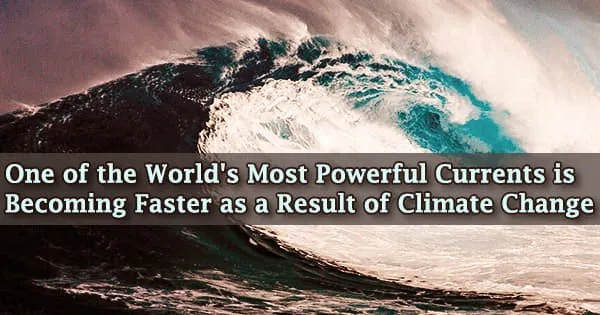The only ocean stream that circumnavigates the globe, the Antarctic Circumpolar Current (ACC), is speeding up. Using a decades-long set of observational records, scientists are able to tell that this is happening for the first time.
When the atmosphere traps heat radiating from the earth toward space is attributed by scientists to the human expansion of the “greenhouse effect” warming that has been detected since the mid-twentieth century.
The presence of some gases in the atmosphere prevents heat from escaping. Long-lived gases that remain in the atmosphere semi-permanently and do not respond physically or chemically to temperature changes are referred to as “forcing” climate change.
Researchers from UC San Diego’s Scripps Institution of Oceanography, Woods Hole Oceanographic Institution, the Chinese Academy of Sciences, and UC Riverside used satellite measurements of sea-surface height and data from the Argo global network of ocean floats to uncover a previously unknown trend in Southern Ocean upper layer velocity.
Fossil fuel combustion produces greenhouse gas emissions, which act as a blanket around the Earth, trapping the sun’s heat and boosting temperatures. Carbon dioxide and methane are two examples of greenhouse gas emissions that contribute to climate change.
The findings of the Southern Ocean Carbon and Climate Observations and Modeling (SOCCOM) project, which is financed by the National Science Foundation, are published in the journal Nature Climate Change on 29th November 2021.

The albedo of the Earth’s surface is reduced when snow cover and sea ice in the Arctic are reduced. More of the Sun’s energy is now absorbed in these areas, causing Arctic temperature swings to be amplified. Permafrost is melting as a result of Arctic amplification, releasing methane and CO2 into the atmosphere.
From both observations and models, we find that the ocean heat change is causing the significant ocean current acceleration detected during recent decades. This speedup of the ACC, especially its jet centered on the Subantarctic Front, facilitates property exchange, such as of heat or carbon, between ocean basins and creates the opportunity for these properties to increase in subsurface subtropical regions.
Jia-Rui Shi
As the climate warms, the predominant westerly winds have accelerated. Models suggest that increasing wind speed has little effect on ocean currents. Rather, it energises ocean eddies, which are circular water flows that travel in the opposite direction of the main currents.
“From both observations and models, we find that the ocean heat change is causing the significant ocean current acceleration detected during recent decades,” said Jia-Rui Shi, formerly a Ph.D. student at Scripps Oceanography and currently a postdoctoral researcher at Woods Hole Oceanographic Institution.
“This speedup of the ACC, especially its jet centered on the Subantarctic Front, facilitates property exchange, such as of heat or carbon, between ocean basins and creates the opportunity for these properties to increase in subsurface subtropical regions.”
The Antarctic Circumpolar Current (ACC) encircles Antarctica, separating cold subtropical water to the south from milder subtropical water to the north. This warmer section of the Southern Ocean absorbs a large portion of the heat that humans are putting into the atmosphere. As a result, experts believe it is critical to comprehend its dynamics, as what occurs there could have a global impact on climate.
The pattern of ocean warming is crucial. Currents between warm and cold waters speed up as the gradient, or degree of heat difference, between them increases.
“The ACC is mostly driven by wind, but we show that changes in its speed are surprisingly mostly due to changes in the heat gradient,” said co-author Lynne Talley, a physical oceanographer at Scripps Oceanography.
Before the advent of satellite-mounted equipment and the Argo network, long-term data capturing changes in the Southern Ocean was difficult to come by. The network of self-contained floats, which monitor ocean parameters such as temperature and salinity, was established in 1999 and reached full capacity in 2007.
To this day, a full complement of 4,000 floats continues to collect data across the world’s oceans. The researchers were able to discern the speeding current’s trend from natural variability using more than a decade’s worth of Argo data.
According to the study’s co-authors, the current’s speed is anticipated to climb much more if the Southern Ocean continues to absorb heat from human-caused global warming.
The research team comprised Shang-Ping Xie of Scripps Oceanography, Qihua Peng of the Chinese Academy of Sciences, and Wei Liu of UC Riverside, in addition to Shi and Talley.
















